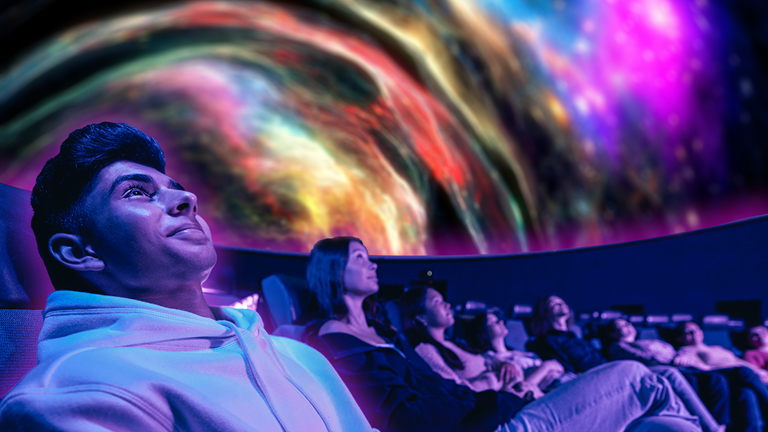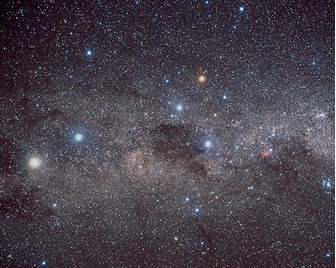Skynotes: April 2023
Upcoming events
Mars space travel, health and fiction
ANU is researching how effective fiction is in the social understanding of the health concerns of Mars space travel, and you are invited to contribute!
Melbourne Sun times*
| Date | Rise | Set | Day length | Solar noon§ |
|---|---|---|---|---|
| Sat 1 | 7:33 | 7:14 | 11:40hrs | 1:24 |
| Mon 11 | 6:42 | 5:59 | 11:16hrs | 12:21 |
| Fri 21 | 6:51 | 5:45 | 10:54hrs | 12:18 |
| Sun 30 | 6:59 | 5:34 | 10:35hrs | 12:17 |
* Daylight Savings ends 3am, Sunday 2 April, with clocks turned back 1 hour.
§ When the sun is at its highest, crossing the meridian or local longitude.
Moon phases
| Phase | Date |
|---|---|
| Full Moon | Thursday 6th |
| Third Quarter | Thursday 13th |
| New Moon | Thursday 20th |
| First Quarter | Friday 28th |
Moon distances
Lunar perigee (closest to Earth) is on Sunday 16th at 367,968km.
Lunar apogee (furthest from Earth) is on Friday 28th at 404,299km.
Planets
Mercury is an evening planet this month, but not able to be seen from Melbourne.
Venus will be visible this month in the north-west from 6pm before setting by 7.40pm.
Mars will be in the north from 6.30pm until 10pm when it will set in the north-west.
Jupiter has taken its journey behind the sun but is still too close to the sun to be seen.
Saturn, like Jupiter, has passed behind the sun but will be visible from around 2.30am in the east before fading by 6am in the early morning light.
Meteors
April’s main shower, The Lyrids, is centred near the bright star Vega low in the north at 3am. It is active from 16th–25th peaking on the 22nd–23rd. Better placed is the Pi-Puppids associated with Comet Grigg-Skjellerup which peaks on 24th centred low in the south-west near Canopus in Carina.
Stars and constellations
In the south
The Southern Cross can be found on its side in the south-east with the Two Pointers below. To the right of the Cross, in the south-western sky, is the star Canopus, the second brightest star in the night sky. Low in the south is Achernar, the head of the river Eridanus. Achernar never sets in Melbourne and is called a circumpolar star as moves through a half-circle around the South Celestial Pole during the night as Earth rotates on its axis.
Here is a superb view of a special place in the night sky taken by the AAT - the Southern Cross and Pointers. The Anglo-Australian Telescope forms part of the Australian Telescope Observatory (AAO) at Siding Spring in NSW which hosts a variety of telescopes and detectors studying the sky. The image above reveals a region of the galaxy densely packed with millions of stars and reveals their colours which, seen in long exposures like this one, indicates a star’s surface temperature – blue for hot stars and orange-yellow for cooler ones.
The dark Coal Sack dust cloud sits at centre with the five stars of the Southern Cross above and to the right. At left are the two Pointers, Alpha and Beta Centauri, with the brighter at far left being Alpha Centauri, the nearest star system to our own.
In the south-west
If you are away from bright city lights, you can see the Large and Small Clouds of Magellan, two small neighbouring galaxies to our own Milky Way. They appear as irregular fuzzy patches isolated away from the broad band of stars that runs across the sky and is our edge-on view of own galaxy.
In less light-polluted skies you can easily see in the Milky Way several dark regions that are vast clouds of dust. Whilst we may see a few foreground stars, the dark areas behind obscure our view of more distant stars of the galaxy. The obvious dark one adjacent to the Cross is the Coal Sack.
In the west
Orion, the hunter, is in the west lying almost on his side with the red-giant star Betelgeuse as one of his shoulders. The three bright stars that form an obvious line are Alnitak, Alnilam and Mintaka. They mark his belt and also conveniently the base of the local ‘Saucepan’ asterism. The handle of the saucepan is Orion’s scabbard which hangs from his belt. Continuing the belt stars above and a little to the right we reach Sirius, the brightest star in the night sky and principal star in Canis Major (greater or larger dog) which is one of Orion’s hunting dogs. Below Sirius in the north-west is Procyon which marks the position of his lesser or smaller dog Canis Minor.
Below Orion and drawing closer to the horizon during the month is the Hyades, an open group of stars that form a sideways wedge or V. This is the triangular head of Taurus, the bull, with his ‘angry eye’ as the red-giant star Aldebaran on the corner.
In the north
In the north but upside down from our southern hemisphere perspective is Leo, the lion. This constellation is easily recognised by the hook shape (or inverted backwards question mark) of stars that forms the mane on the lion’s head and shoulders.
To the left of Leo and close together are the two bright stars Castor and Pollux, the principal stars in the constellation of Gemini, the twins which appears upside down as well from southern latitudes.
In the east
Later this month and into May the spectacular constellation of Scorpius will begin its return to our evening skies. This is one of the largest constellations and when it appears low in the east you can easily identify to the left its long curving tail leading to its body containing the red-giant star Antares marking its heart, and to the right its pincers reaching out.
BlueWalker 3 Satellite
A private communications satellite by AST SpaceMobile was launched by Falcon 9 rocket on 11 September 2022 to a low Earth orbit of 500km. With a mass of 1500kg and a deployed size of 8 x 8 metres, Bluewalker 3 has been developed to enhance broadband and mobile phone coverage. Its flat-panel antenna array of 64 square metres is larger than many objects in orbit. It’s brightness (or magnitude) overhead is regularly observed to be equivalent to or greater than the International Space Station, the largest object in Earth orbit.
Its high reflectivity while in sunlight is being closely monitored by the space and astronomy community for its effect on stargazing or astronomical research. The company plans to launch at least 100 similar satellites to low Earth orbit over the next 20 months.
Other satellite ‘constellations’, such as Starlink, have already appeared in low Earth orbit and are being assessed for the same reasons.
Skynotes visited the issue in April 2020: Satellites – we need them, but problems are coming
Some recent news and reactions:
International Space Station
ISS orbits every 90 minutes at an average distance of 400 km appearing like a bright star moving slowly across the night sky. Here are some of the brightest passes expected this month over Melbourne and Central Victoria:
Morning
- Saturday 8th, 6.02am-6.06am, South-West to North-East.
- Monday 9th, 5.16am-5.20am, South-West to East-North-East.
Evening
- Sunday 16th, 7.26pm-7.29pm, North-West to East-North-East.
- Wednesday 19th, 6.35pm-6.42pm, West-North-West to South-East.
Heavens Above gives predictions for visible passes of space stations and major satellites, live sky views and 3D visualisations. Be sure to first enter your location under ‘Configuration’.
On this day
1st 1948, Alpha, Bethe and Gamow publish their famous paper on the ‘hot Big Bang’.
2nd 1845, Fizeau and Foucault take the first photograph of the Sun.
3rd 1966, Luna 10 (USSR) became the first spacecraft to orbit the Moon.
6th 1973, Pioneer 11 (USA) probe launched to Jupiter and Saturn.
8th 1732, birth of David Rittenhouse who determined Earth-Sun distance of 150 million km.
9th 1959, NASA’s first cohort of astronauts, “the Mercury 7”, are announced.
11th 1905, Einstein’s ‘Special Theory of Relativity’ is published.
11th 1970, Apollo 13 (USA) was launched on its ill-fated mission.
12th 1633, Galileo’s trial by the Catholic Inquisition, on the question of a sun-centred solar system, begins in Rome.
12th 1961, Yuri Gagarin (USSR) became the first human in space orbiting Earth for 108 minutes in Vostok 1.
12th 1981, Columbia (USA) was the first space shuttle to be launched.
14th 1629, birth of Christiaan Huygens who explained Saturn’s rings and discovered its largest moon Titan.
16th 1495, birth of Petrus Apianus who established that cometary tails at all times point away from the Sun.
18th 1971, Salyut 1 (USSR), the first space station, was launched.
19th 1975, first Indian satellite, Aryabhata, is launched.
21st 1990, the Hubble Space Telescope (HST) was launched on the space shuttle Discovery.
23rd 1992, COBE satellite reveals microwave temperature variation across universe.
27th 2002, final telemetry received from probe Pioneer 10 (USA).
28th 1900, birth of Dutch astronomer Jan Oort whose name is given to a vast cloud of icy objects thought to orbit the sun well beyond the Kuiper Belt.
28th 2001, American Dennis Tito became first space tourist paying the Russian Space Agency $US20 million to travel on a Soyuz craft to the ISS for an 8-day journey.
30th 1006, brightest supernova ever recorded is seen in the constellation of Lupus.

